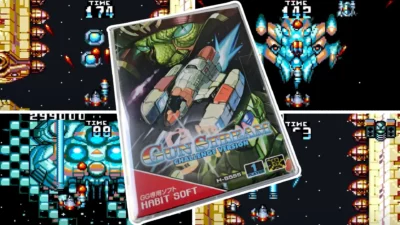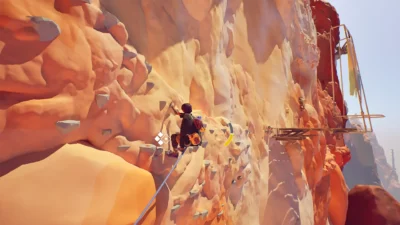
The world of Eastern Exorcist is, quite simply, gorgeous: trees sway in the breeze and mountains loom up through distant mists while, in the foreground, an army of supernatural creatures leap and slither into view. Chinese indie studio Wildfire Game’s 2D hack-and-slash is steeped in its own country’s artwork, storytelling, and folklore, with every frame crafted with precision and care.
It’s all the more remarkable, then, that such an engrossingly taut and beautiful-looking game was made by a tiny studio working on a minuscule budget; when work began on Eastern Exorcist about three years ago, there were just four developers working on it from the discomfort of an old sofa. Back then, developer and studio co-founder Shaoyan Chen had just left a much larger game company, and had sunk his meagre savings into the new project. “That was very tough for us at the beginning,” Chen recalls. “We invested by ourselves and realised it would be [financially] hard for a long time. Therefore, monitors, computers, and sofas were all bought second-hand, to save anything we could.”
Working together in a single room, the fledgling team spent just under a year building an initial prototype, which soon attracted vital interest from investors; with that extra funding secured, the studio expanded from four developers to ten. “Then it took another year to complete a significant milestone in the game, and we went to find a publisher,” Chen continues, referring to Chinese video-sharing platform turned game publisher, Bilibili. “But every time we got new funds, they were mainly invested in the game, which means our lifestyle hardly changed.”

The game’s use of foreground layers gives the 2D artwork real atmosphere and depth.
Tough going
Working conditions may have remained austere, but Eastern Exorcist soon burgeoned into the eye-catching experience that first hit Steam Early Access in August. Taking its cue from games as varied as Dark Souls, Ori and the Blind Forest, Salt and Sanctuary, and Onimusha: Warlords, Eastern Exorcist is an unspeakably tough yet rewarding action fantasy; your protagonist, the athletic exorcist of the title, is capable of flipping and slashing his sword through enemies both large and small – which is just as well, since the game’s world positively heaves with a wild menagerie of demons and monsters. Like Dark Souls, Eastern Exorcist’s bosses will take time, patience, and mastery of blocks, attacks, and parries to defeat, but the game’s tight controls and captivating visuals make practice more than worthwhile.
Created in Unity, Eastern Exorcist mixes 2D hand-drawn artwork and 3D models to craft the illusion of a hand-painted world inspired by Chinese artists such as Quanzong Zhang and Zixi Wei; there are real moments of drama and imagination here, too – we were particularly taken by a boss encounter on a weather-beaten jetty, in which a huge aquatic beast (or Fish Fiend, as the game calls it) leaps from the foaming sea and lunges at the player with its snapping jaws. Eastern Exorcist may have a fraction of the budget of your typical triple-A game, but it more than makes up for this through sheer artistry – and, Chen points out, the team’s willingness to push themselves to uncomfortable lengths to achieve the results they were after. “The animation was made by combining traditional, hand-drawn keyframes and software tweening,” Chen explains. “This shouldn’t be a problem for a professional developer, but it takes time to design… it was basically done by increasing our working hours and reducing our salaries. There were no shortcuts. It was just that everyone wanted to get the project done.”

The splashy bursts of colour when a successful blow lands make Eastern Exorcist’s combat immensely satisfying.
Or course, long working hours and low pay aren’t sustainable practices at any level of game development, and Chen admits that “how to balance life and work also needs to be considered” now that Eastern Exorcist is in Early Access. But with Wildfire Game now looking to Eastern Exorcist’s next phase – “We need to polish and adjust what we’ve already shown to players,” he says – and a port to PlayStation 4 planned, Chen hopes that the game will be successful enough to ease the difficulties the studio has felt over the past three years.
“We’ve been short of money since the beginning of the project,” says Chen. “More money can speed up the development, and also can lead to a better life for our developers. I hope that after the launch of the product, we’ll achieve profitability so that we can have less economic pressures in the future.” But, he adds, “we’re still keeping that old sofa.”
Magnificent Muramasa
One of the games Shaoyan Chen cites as an influence on Eastern Exorcist is the wonderful Muramasa: The Demon Blade, or Oboro Muramasa as it’s known in Japan. Developed by Vanillaware and released for the Wii in 2009, it’s arguably among the prettiest games ever made for Nintendo’s remote-waggling system. Like Eastern Exorcist, it’s a side-scrolling hack-and-slash with painterly graphics and a strong folklore theme. Aside from a 2013 port to the PlayStation Vita, though, Muramasa has so far failed to emerge for other systems – a pity, as we’d love to see its vibrant, fluid visuals remastered in glorious HD. Until that happens, at least we have Eastern Exorcist.





